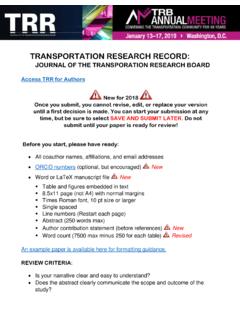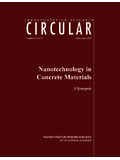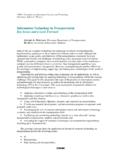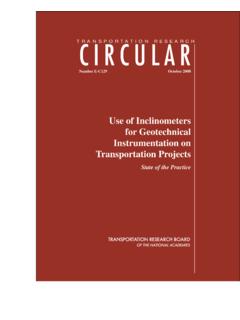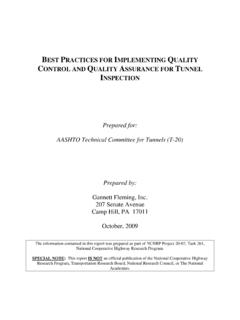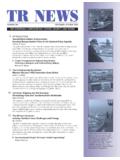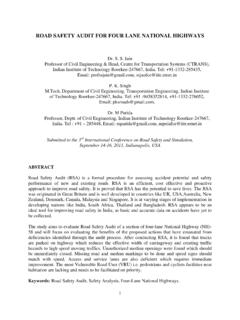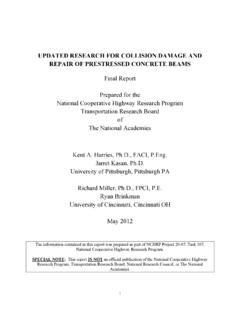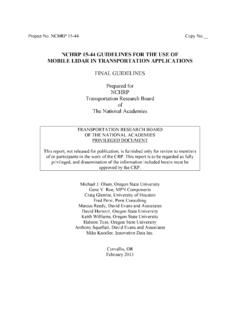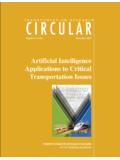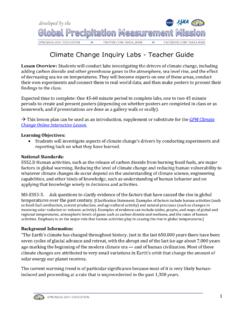Transcription of PRINCIPLES OF SCIENTIFIC INQUIRY
1 Chapter 2. PRINCIPLES OF SCIENTIFIC INQUIRY . Introduction This chapter provides a summary of the PRINCIPLES of SCIENTIFIC INQUIRY . The purpose is to explain terminology, and introduce concepts, which are explained more completely in later chapters. Much of the content has been based on explanations and examples given by Wilson (1). The SCIENTIFIC Method Although most of us have heard, at some time in our careers, that research must be carried out according to the SCIENTIFIC method , there is no single, SCIENTIFIC method. The term is usually used to mean a systematic approach to solving a problem in science. Three types of investigation, or method, can be recognized: The Observational Method The Experimental (and quasi-experimental) Methods, and The Survey Method.
2 The observational method is most common in the natural sciences, especially in fields such as biology, geology and environmental science. It involves recording observations according to a plan, which prescribes what information to collect, where it should be sought, and how it should be recorded. In the observational method, the researcher does not control any of the variables. In fact, it is important that the research be carried out in such a manner that the investigations do not change the behaviour of what is being observed. Errors introduced as a result of observing a phenomenon are known as systematic errors because they apply to all observations. Once a valid statistical sample (see Chapter Four) of observations has been recorded, the researcher analyzes and interprets the data, and develops a theory or hypothesis, which explains the observations.
3 The experimental method begins with a hypothesis. An experiment is designed to test the hypothesis by observing the response of one variable to changes in a limited number of other variables under controlled conditions. The data are analysed to determine whether a relationship exists which either confirms or refutes the hypothesis. The experimental method is frequently used in investigations in the physical sciences and engineering. The essential steps in the observational and experimental methods are illustrated in Figure 2. In both methods, establishing relationships may include the development of models to explain the relationships being postulated. Occasionally, the observational method may lead to a hypothesis, which is subsequently tested by the experimental method.
4 Volume I: page 19. Figure 2: Steps in the Observational and Experimental SCIENTIFIC Methods Surveys and are a means of obtaining information not generally available under other circumstances, and are often used in the social sciences. The most common examples in transportation involve driver behaviour. As with the observational method, it is important that the act of collecting the data not change the behaviour being recorded, but, unlike observations, there is usually some interaction between the researcher and the subjects being studied. Three types of surveys can be recognized: historic, current and prospective. Historic surveys collect data on how things were in the past with the intent of explaining certain phenomena.
5 A current survey examines how things are now, such as attitudes to new traffic signs. A prospective survey selects a group of people today and examines the same people at future times to investigate changes. Prospective surveys are often used in medical research, for example, to examine the incidence of cancer or heart disease in a segment of the population. The terms theory and hypothesis are sometimes used interchangeably, but there is an important distinction between the terms. A hypothesis is an idea put forward to explain certain facts, and which can be tested. A theory is broader in scope and constitutes a conceptual framework that seeks to explain the connection of events and enables other relationships to be predicted.
6 From a theory, it should be possible to derive testable hypotheses, which, if supported by the data, enhance the validity of the theory. Usually, many related hypotheses have to be tested and verified, before one has confidence in the validity of a theory. The connection between the data and the hypothesis is much stronger than between the data and the theory, which is conceptual and results from an intellectual process. Volume I: page 20. Hypothesis A hypothesis is a trial idea concerning the nature and connection of events. Hypotheses can be stated in a number of different forms (6). The declarative form states a relationship between the variables that the researcher expects will emerge. For example, There will be a significant difference in the 3-day strength of concrete made with Type III (high early strength) cement compared with concrete made with Type I (ordinary Portland) cement.
7 Another form is the null hypothesis, or the hypothesis to be nullified. A special case of the null hypothesis is the nil hypothesis which states that no relationship exists between the variables concerned. For example, in nil form, the hypothesis becomes, There will be no significant difference in the 3-day strengths of concretes made with Type I and Type III cements . The nil hypothesis does not necessarily reflect the researcher's expectations, but is used because it is better suited to statistical techniques, many of which are designed to measure the likelihood that a difference found is truly greater than zero. In other words, the nil hypothesis, in the form usually used in science and engineering, states that no difference exists, and the statistical tools test this hypothesis by determining the probability that whatever difference is recorded by the experimental data is a true difference that will be present in the population from which the samples have been drawn.
8 It is important to note that the form of the test hypothesis can favor, disadvantage, or be neutral to the challenging or alternative hypothesis. The researcher should be aware of the implications of the form of the nil and alternative hypotheses, and the practical implications of these choices. For instance, if the cost of conversion (from a standard method, procedure, etc.) is high, then the hypothesis might be chosen to put the challenger at a disadvantage, thereby helping to insure that change will occur only if the challenger is truly better. The null and nil hypotheses can sometimes be confusing, especially to students, because it is the exact opposite of one's expectations. One way to overcome this problem is to use a research hypothesis that reflects one's expectations, and a statistical hypothesis, which is usually the null hypothesis, and which allows a more precise statistical evaluation of the research hypothesis.
9 Hypotheses may also be stated in question form. For example, Is there a significant difference in the 3-day strength of concrete made with Type I or Type III cement? This form is often the easiest for the inexperienced research worker because it states specifically the question the researcher is attempting to answer. In cases where the researchers have good reason to expect a difference to occur in a specific direction, the hypothesis may be stated (using the same example) as The 3-day strength of concrete made with Type III cement will be significantly greater than the 3-day strength of concrete made with Type I cement , referred to as the null hypothesis. This type of hypothesis should only be used where there is little or no possibility that the data will yield a difference in the opposite direction.
10 These two forms of declarative hypothesis call for a different statistical treatment. If the difference could occur in either direction, a two-tailed test is required, whereas a one-tailed test presumes that, if a difference occurs, it could occur in only one direction. In the experimental method we begin by postulating a relationship, and then designing an experiment that will either support or refute our hypothesis. For example, if our hypothesis states that air and water are necessary to cause the corrosion of steel, we can construct the following simple experiment. We place nails in three test tubes, one containing de-aerated water, one with oxygenated water, and the other containing dry air. If the nails in oxygenated water begin to rust, but those in the other two test tubes do not, we can conclude that our hypothesis is valid.
